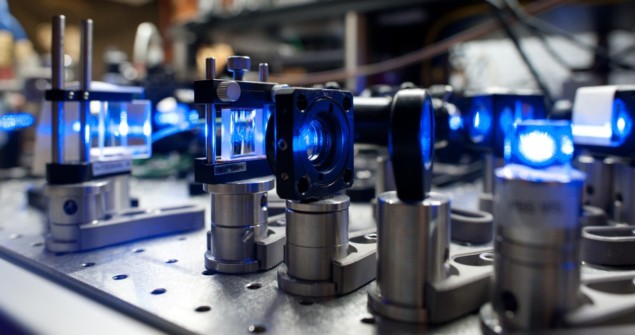
A manifestation of the Pauli exclusion principle in ultracold atomic gases has been spotted for the first time by three independent research groups. Called Pauli blocking, the effect was first predicted 30 years ago and occurs when fermionic atoms in a quantum gas are unable to make transitions to nearby quantum states.
In the three experiments, Pauli blocking reduced the ability of atoms to scatter light, making the gases more transparent. The effect could someday be used to improve technologies based on ultracold atoms such as optical clocks and quantum repeaters.
Famous principle
Particles with half-integer spin obey Fermi-Dirac statistics, which arises from symmetry considerations in quantum mechanics. Such particles are called fermions and they obey Pauli’s famous exclusion principle, which says that fermions cannot occupy the same quantum state in a system.
Electrons are fermions and the exclusion principle explains why individual electron orbitals in an atom can contain at most two electrons – one spin-up and the other spin-down. This gives us the varied properties of the different atoms in the periodic table. The exclusion principle is also at work in semiconductors and insulators, where electrons are unable to respond to the application of small electric fields because doing so would require moving to another quantum state – and in semiconductors and insulators, most nearby states are all full.
Degenerate gases
Many atoms are fermions and now physicists can chill some fermionic atomic gases to low enough temperatures that nearly all the low-lying quantum states are filled to what is called the Fermi level. Such dense, ultracold systems are said to be degenerate and the atoms are expected to behave in a similar way as electrons in a solid.
Instead of applying an external field to try to get the atoms to move, the three research teams fired photons of light at their degenerate Fermi gases. Normally when light is shone on an atomic gas, some of the photons will scatter from the atoms and the atoms will recoil, taking some energy and momentum from the photon.
However, in a degenerate Fermi gas of atoms, this recoil often requires a transition to a nearby quantum state that is occupied by another atom. As a result, the scattering cannot occur, and the photon will carry on through the gas. The observable effect of this is an increase in the transparency of the gas as it is cooled to the point where it starts to become degenerate. In the three experiments reported today, this was observed when gases were cooled to temperatures in the microkelvin and nanokelvin range.
Forward scattering
At JILA – a joint institute of the US National Institute of Standards and Technology and the University of Colorado – Christian Sanner and colleagues focused on the angles at which photons scattered from their ultracold gas of strontium-87 atoms. They found that forward scattering – whereby the photons experience small deviations in their trajectories and atomic recoils are small – was suppressed.
This is consistent with atoms in the gas being Pauli blocked from making small transitions to nearby quantum states. However, photon scattering involving larger atomic recoils was not as suppressed. This is consistent with atoms being able to make large transitions to unoccupied states above the Fermi level.
Meanwhile in New Zealand, Amita Deb and Niels Kjærgaard at the University of Otago compared the optical properties of a potassium-40 fermionic gas with that of a gas made of rubidium-87. This isotope of rubidium obeys Bose-Einstein statistics and is therefore not subject to Pauli blocking. When cooled to ultracold temperatures, the transparency of the potassium-40 gas increased whereas the transparency of the rubidium-87 gas did not.
The third group is based at the Massachusetts Institute of Technology (MIT) and includes the Nobel laureate Wolfgang Ketterle. This team cooled fermionic lithium-6 atoms to below the Fermi level and also observed an increase in transparency. This team noted that the effect disappeared as they increased the intensity of the light that they shone on the sample. This, they say, is the result of light scattering heating up the sample.
Density fluctuations
The MIT team has also proposed an alternative explanation for the transparency observations of all three teams. Light can scatter from density fluctuations in a fluid, and if these fluctuations are about the same size as the wavelength of light, the fluid will become opaque. This occurs in milk, where suspended protein clusters create the appropriate density fluctuations.

Physicists close in on a simpler route to quantum degenerate molecules
Ketterle and colleagues point out that a lack of density fluctuations has already been observed in ultracold Fermi gases. This occurs because the Pauli exclusion principle prevents atoms from getting very close together, which makes the density of the gas very homogenous. This dearth of density fluctuations, say the researchers, could also explain the increase in transparency at low temperatures.
Ultracold atomic gases have a growing number of applications including atomic clocks and components for quantum networks. Pauli blocking could be used to improve existing technologies and possibly develop new applications.



